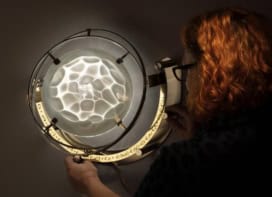
By James Dacey
At first they may seem painfully slow and innocuous but give them an afternoon or so in your garden and they will have gobbled up your lilies before moving on to your prize-winning cabbages.
The way slugs and snails move around has captured the interest of researchers in Spain and the US, who are interested in how these slimy gastropods manage to effectively drag themselves through glue using just one foot.
Bioscientists already know that slugs and snails move by expanding and contracting their body in a series of muscular wave motions passing from the tail through to their head. What is less clear, however, is the role in locomotion played by the sticky mucus secreted from glands on the underside of the foot. This fluid is non-Newtonian, which basically means it does not deform in simple, predictable ways, like water for instance.
To investigate these slimy movements, Javier Rodríguez, a fluid dynamics researcher at the University of Carlos III in Madrid, working with colleagues at Stanford University and the University of California at San Diego, studied the gastropods in confined conditions. They captured a range images and other data of slugs and snails as they glided over transparent surfaces, which they then combined into 3D reconstructions.
To measure the speed of the body waves, for instance, they illuminated the snail’s foot from underneath using lights. Then to measure the vertical deformation of the body they shone a laser on the foot from a range of different angles (we’re informed it was a low-power laser so as not to harm the snails…)
Publishing their findings in the Journal of Experimental Biology, Rodríguez and co found is that the motion of slugs and snails has everything to do with the muscle movements of the slugs and snails and very little to do with the fact that the mucus is non-Newtonian.
Now, this may not sound like a particularly exciting result but it is good news for engineers who are trying to build robots that can drag themselves over surfaces in the same way as snails. The latest findings mean that machines could be rolled out in any old mucus and they would not need to fitted with personal supplies of special fluids.
One such idea, being proposed by a separate research group based in Japan, is to use the snail propulsion mechanism in biomedical applications to transport devices around the body. They envisage an endoscope being passed through the digestive system, taking advantage of the mucus film that lines the gastric tracts.
And if you have been left wondering why slugs and snails may have evolved to secrete complex non-Newtonian fluids, well it could be to serve other biological functions. “Without a doubt, it could have other uses, such as climbing walls, moving upside-down, or preserving moisture in the body when on a dry surface,” says Rodríguez.



